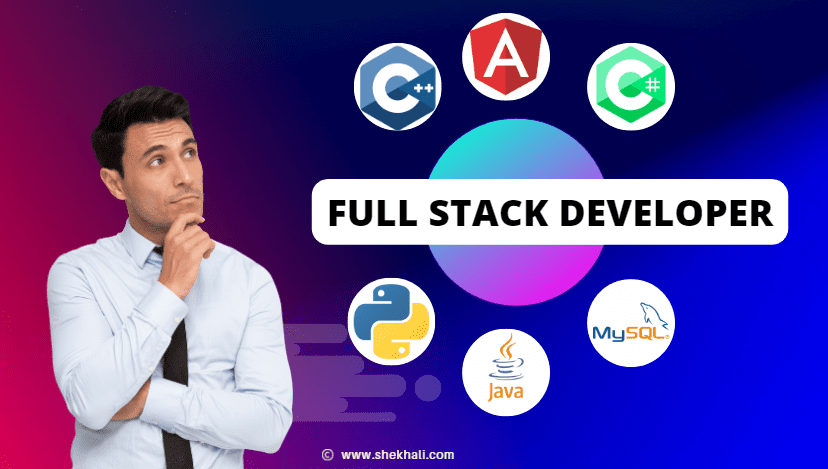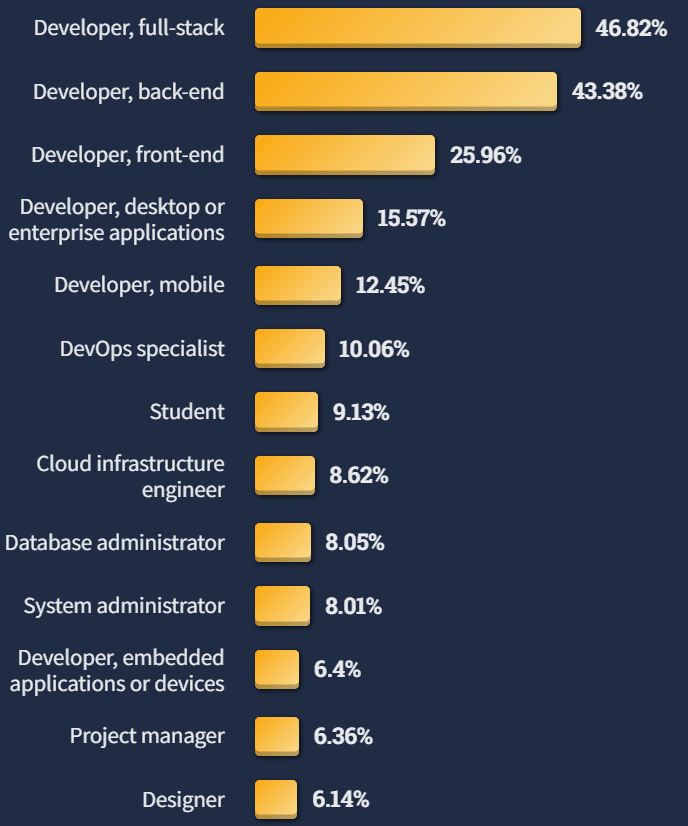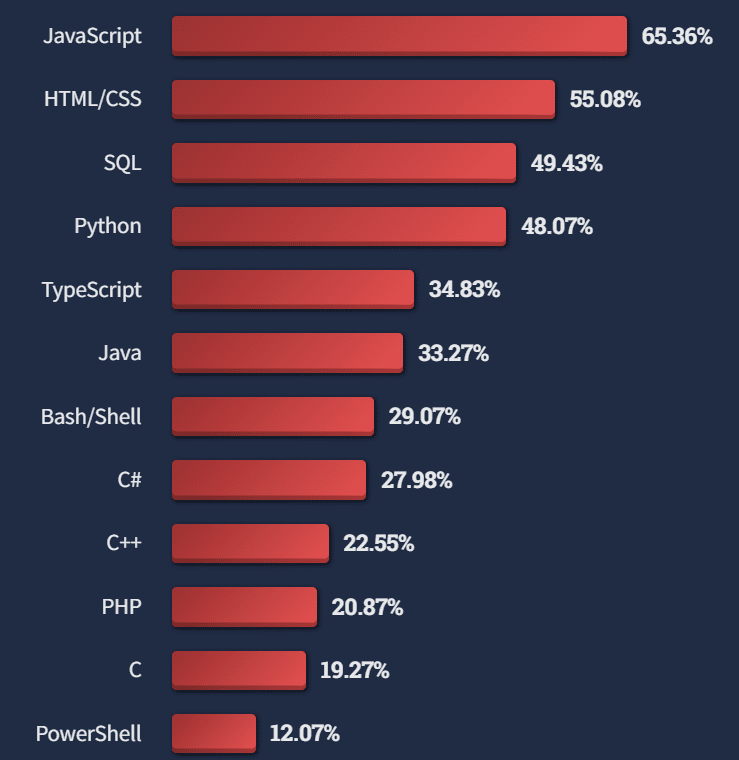Are you interested in becoming a full-stack developer? Do you want to know what it takes to become one? If so, you are in the right place. In this article, we will define what is a full stack developer, their skills, and the technologies they use.
We will also give you the steps to become a full stack developer in 2023 and information on the average full stack developer salary.

Table of Contents
- 1 What is a Full Stack Developer?
- 2 Skills of a Full Stack Developer
- 3 Front-end Languages and Frameworks
- 4 Backend Technologies and Frameworks
- 5 Required Server/Hosting Skills
- 6 What Does Full Stack Developer Do?
- 7 What is the average full stack developer salary?
- 8 FAQs:
- 8.1 Q: What is a full stack developer?
- 8.2 Q: What skills are required to become a full stack developer?
- 8.3 Q: What is the average salary for a full stack developer?
- 8.4 Q: What back-end technologies and frameworks should a full stack developer know?
- 8.5 Q: What front-end languages and frameworks should a full stack developer know?
- 8.6 Related
What is a Full Stack Developer?
A full stack developer is a software developer who works on both the front-end and back-end of web applications. They have a wide range of skills and knowledge that enable them to create full-stack web applications from start to finish. It includes designing the user interface, writing the business logic, and working with databases.
A full stack developer must also be able to deploy and maintain the application on the server.
Skills of a Full Stack Developer
A full stack developer should have a strong foundation in computer science, programming languages, and web development. Some of the skills a full stack developer should have included the following:
- Front-end development using HTML, CSS, and JavaScript
- Backend development using programming languages such as PHP, Python, Java, .Net, or Ruby
- Knowledge of database management systems like SQL Server, MySQL, MongoDB, or PostgreSQL
- Familiarity with server-side languages like Node.js or Ruby on Rails
- Experience working with APIs and integrating third-party services
- Understanding of web application security
- Version control with Git
- Familiarity with cloud services like Amazon Web Services (AWS) or Google Cloud Platform
In a survey conducted by Stack Overflow in 2022, which included 61,302 developers from around the world, it was found that approximately 46.82 percent of the respondents identified themselves as full-stack developers. In comparison, 43.28 percent of those surveyed identified themselves as back-end developers, 25.96 percent as front-end developers, and only 12.45 percent claimed to be mobile developers.

Front-end Languages and Frameworks
Front-end development is part of web development that involves creating the user interface and experience. Some of the most popular front-end languages and frameworks include:
- HTML: HyperText Markup Language is used to structure content on the web.
- CSS: Cascading Style Sheets are used to style web pages and make them visually appealing.
- Bootstrap: A free and open-source CSS framework that simplifies the development of responsive websites and web applications.
- JavaScript: A programming language used to create interactive web pages and applications.
- jQuery: A popular JavaScript library that simplifies HTML document traversal and manipulation, event handling, and Ajax.
- React: A JavaScript library for building user interfaces.
- Angular: A TypeScript-based open-source web application framework.
- Vue.js: A progressive JavaScript framework for building user interfaces.
- Sass: A CSS preprocessor that allows you to use variables, nesting, and mixins to write cleaner and more maintainable CSS code.
- Ember.js: A JavaScript framework for building complex web applications that use multiple routes, templates, and models.
- Backbone.js: A lightweight JavaScript framework that provides a basic structure for organizing your client-side code and interacting with your server-side API.
- Polymer: A JavaScript library for building web components, which are reusable and encapsulated HTML, CSS, and JavaScript blocks.
By learning these front-end languages and frameworks, you can expand your skills as a full stack developer and create even more powerful and feature-rich web applications.
Backend Technologies and Frameworks
Backend development is part of web development that deals with the server side of web applications. Some of the most popular backend technologies and frameworks include:
- Node.js: A JavaScript runtime built on Chrome’s V8 JavaScript engine.
- Ruby on Rails: A web application framework written in Ruby.
- Django: A high-level web application framework for Python, used for building scalable and secure web applications.
- Laravel: A PHP web application framework with expressive, elegant syntax.
- Flask: A micro web framework written in Python for building small to medium-sized web applications.
- Express.js: A popular web application framework for Node.js, used for building APIs and web applications.
- ASP.NET: A web application framework for Microsoft’s .NET platform for building enterprise-level web applications.
Most commonly used Programming, scripting, and markup languages
In 2022, JavaScript will remain the most widely used programming language for ten consecutive years. However, the landscape is different for individuals who are learning to code. HTML/CSS, JavaScript, and Python are almost equally popular among beginners. Those who are learning to code are more inclined towards these languages than professionals.
Following is the Stack Overflow survey 2022 about the most popular technologies.

Required Server/Hosting Skills
A full stack developer should have knowledge of server and hosting skills. Some of the skills that a full stack developer should have included are the following:
- Setting up a server and configuring it.
- Managing and scaling servers.
- Deploying web applications to a server.
- Knowledge of cloud services such as Amazon Web Services, Google Cloud Platform, and Microsoft Azure.
What Does Full Stack Developer Do?
A full stack developer is responsible for developing and maintaining a web application’s front-end and back-end. That means they are involved in everything from designing the user interface and user experience (UI/UX) to setting up the server-side infrastructure and database.
Here are some specific tasks that a full stack developer may perform:
- Collaborating with designers to create visually appealing and intuitive interfaces that are easy to use and navigate.
- Developing front-end code using HTML, CSS, and JavaScript to create dynamic and responsive web pages.
- Writing server-side code using programming languages like Python, Ruby, or Java to handle user requests and process data.
- Building and maintaining databases using tools like MySQL, MongoDB, or PostgreSQL to store and manage data.
- Deploying and managing web applications on cloud platforms like AWS, Google Cloud, or Microsoft Azure.
- Writing automated tests ensures that the application functions correctly and catches bugs before they become serious issues.
- Optimizing web applications for performance and scalability to handle high traffic and user loads.
In short, a full stack developer is responsible for creating and maintaining web applications from start to finish, using a variety of tools and technologies to build robust, scalable, and user-friendly applications.
What is the average full stack developer salary?
The salary of a full-stack developer in the US can be influenced by their level of professional experience. As their experience increases, they are more likely to be promoted, resulting in higher compensation.
According to Glassdoor, below is a list showing the average salary range of full-stack developers in the US based on their job titles and years of experience.
| Job Title | Years of Experience | Salary Range |
|---|---|---|
| Full-stack developer | 0-1 year | $61,000-$99,000 |
| Mid-level full-stack developer | 1-3 years | $67,000-$106,000 |
| Senior full-stack engineer | 4-6 years | $72,000-$113,000 |
| Principal full-stack engineer | 8+ years | $146,000-$248,000 |
| Vice-president of engineering | 8+ years | $227,000-$396,000 |
FAQs:
Q: What is a full stack developer?
A full stack developer is a programmer with expertise in front-end and back-end web development technologies. They have the skills to develop entire web applications from start to finish, from the user interface to the database and everything in between.
Q: What skills are required to become a full stack developer?
To become a full stack developer, you will need to have a strong foundation in programming fundamentals and expertise in front-end (HTML, CSS, JavaScript, jQuery, Bootstrap) and back-end (NodeJS, ExpressJS, Django, Ruby on Rails, Laravel, Flask, C# .NET, C++) web development technologies.
Some key skills also required include proficiency in databases, web servers, APIs, and software engineering principles.
Q: What is the average salary for a full stack developer?
Full stack developer salaries can vary widely depending on location, experience, and skill level. According to Payscale, the average salary for a full stack developer in the United States is $75,000 annually. However, salaries can range from $50,000 to over $120,000, depending on the job and location.
Q: What back-end technologies and frameworks should a full stack developer know?
Some of the most popular back-end technologies and frameworks a full stack developer should know include Node.js, Ruby on Rails, Django, ASP.NET, Laravel, Flask, and Express.js etc.
These technologies are used to build the server-side infrastructure, handle requests and responses, and manage databases.
Q: What front-end languages and frameworks should a full stack developer know?
Some of the most popular front-end languages and frameworks a full stack developer should know to include HTML, CSS, JavaScript, React, Angular, Vue.js, jQuery, Bootstrap, and Sass.
These technologies create the user interface and make web applications interactive and responsive.
- C# 12 New Features in 2025: What’s New with .NET 8 - April 11, 2025
- Difference Between WCF and Web API with Examples: A Comprehensive Guide - March 27, 2025
- PUT vs PATCH vs POST in REST API: Key Differences Explained With Examples - March 23, 2025